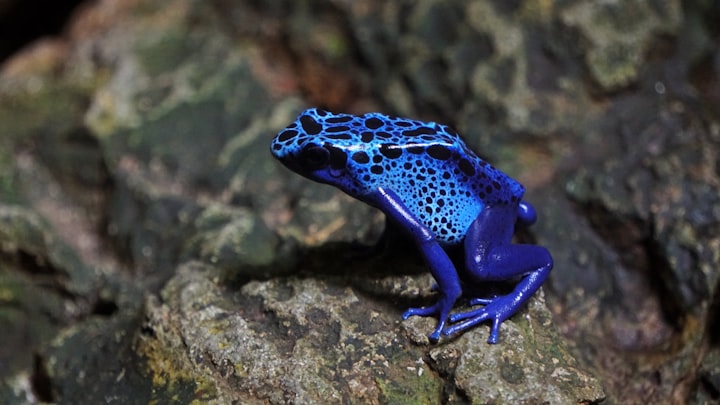
Poison dart frogs belong to the family Dendrobatidae, which comprises over 170 recognized species. They exhibit a remarkable range of vibrant colors, including bright reds, blues, yellows, oranges, and greens. These striking hues serve as a warning to potential predators, indicating their toxicity.
One of the most distinctive features of poison dart frogs is their potent toxins. The toxins, known as alkaloids, are derived from their diet in the wild, which consists mainly of small invertebrates such as ants, beetles, mites, and spiders. It is believed that the frogs accumulate these toxins in their skin as a defense mechanism against predators.
The skin secretions of some species of poison dart frogs are incredibly toxic. For instance, the golden poison frog (Phyllobates terribilis) possesses enough toxin to kill 10 adult humans. It is considered one of the most toxic animals on the planet. However, it's important to note that captive-bred poison dart frogs raised on a diet devoid of toxic insects are harmless.
Indigenous peoples of Central and South America have long utilized the toxins of poison dart frogs. They extract the toxins from the frogs and apply them to the tips of their blowgun darts for hunting. The toxins paralyze or kill the prey upon impact, making it easier to catch.
In the wild, poison dart frogs primarily feed on small invertebrates, especially ants, termites, mites, beetles, and spiders. Their diet plays a crucial role in acquiring the alkaloids that make them toxic.
Poison dart frogs exhibit remarkable parental care. After laying eggs, the female carefully transports the tadpoles to water-filled bromeliad plants or other suitable water sources. The male then guards the eggs and tadpoles until they develop into froglets. The male keeps the eggs moist by urinating on them, preventing them from drying out.
Some non-toxic species of frogs have evolved to mimic the appearance of toxic poison dart frogs. This phenomenon, known as Batesian mimicry, helps them ward off potential predators by imitating the warning colors of their toxic counterparts.
The lifespan of poison dart frogs can vary depending on the species and their environment. In captivity, they can live for about 10 to 15 years, while in the wild, it is believed to be shorter due to predation, disease, and other factors.
Poison dart frogs are primarily found in the tropical rainforests of Central and South America. They inhabit areas with high humidity, such as the Amazon Basin, Costa Rica, Colombia, Brazil, and Panama.
Poison dart frogs are generally small, ranging from about 1 to 6 centimeters in length. Their size and appearance vary depending on the species, but they often have a flattened body, smooth skin, and bright colors.
Despite their vibrant colors, poison dart frogs also possess effective camouflage. Some species have patterns that blend with their environment, allowing them to hide among leaf litter or mimic dead leaves, providing protection from predators.
Poison dart frogs face numerous threats, primarily due to habitat loss caused by deforestation and the expansion of human activities. Pollution, climate change Conservation Efforts:
Conservation organizations, researchers, and local communities are actively engaged in efforts to protect poison dart frogs and their habitats. These include initiatives to preserve rainforests, establish protected areas, conduct scientific research, and raise awareness about the importance of these unique amphibians.
Captive breeding programs play a crucial role in the conservation of poison dart frogs. These programs aim to maintain genetically diverse populations and reduce the demand for wild-caught frogs in the pet trade. Additionally, they contribute to scientific research and educational outreach.
The toxic compounds found in poison dart frogs have attracted the attention of scientists and researchers. Some alkaloids found in their skin secretions have shown potential for medicinal applications, including pain relief and muscle relaxation. However, extensive research is still needed to explore their potential uses.
Despite their small size, poison dart frogs play a vital role in their ecosystems. They contribute to insect control by preying on small invertebrates, helping to maintain the balance of these populations within the rainforest.
Poison dart frogs hold cultural significance in the regions where they are found. Indigenous communities often incorporate these frogs into their folklore, traditions, and spiritual beliefs, adding to the cultural richness of the local communities.
Efforts to raise public awareness and educate communities about the importance of poison dart frogs are crucial for their conservation. By promoting understanding and appreciation for these unique creatures, people are encouraged to support conservation initiatives and protect their habitats.
The study of poison dart frogs continues to yield new insights and discoveries. Scientists are continually uncovering new species, documenting their behaviors, investigating their chemical compounds, and exploring their ecological interactions.
For those interested in keeping poison dart frogs as pets, responsible ownership is crucial. It is essential to obtain captive-bred frogs from reputable breeders and ensure proper care, housing, and nutrition. Additionally, supporting conservation efforts in their natural habitats is equally important.
In conclusion, poison dart frogs captivate us with their vibrant colors, toxic nature, and fascinating behaviors. They remind us of the intricate wonders of the rainforest and the importance of preserving these delicate ecosystems. Through conservation efforts, research, and public awareness, we can strive to protect these remarkable amphibians for generations to come.
About the Creator
Soyini
Perusing is really great for you since it works on your concentration, memory, sympathy, and relational abilities. It can lessen pressure, work on your emotional wellness, and assist you with living longer.





Comments
There are no comments for this story
Be the first to respond and start the conversation.